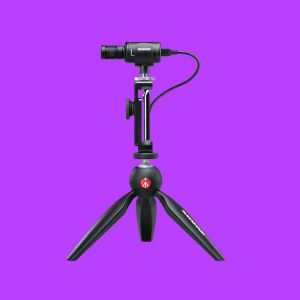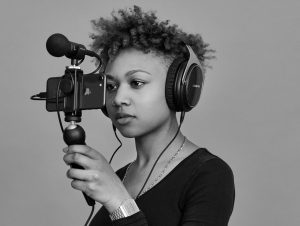Livestreaming is changing the face of the music industry. A big part of the appeal of livestreaming is that it’s relatively simple to pull off—all you need is Shure’s MV88+.
In the early days of the pandemic, workers in various industries were looking for possible silver linings to arise from the global shutdown. The most salient of these was a shift towards flexible working conditions, including the option to work from home.
Live performers and event staff were some of the most harshly affected by Australia’s pandemic restrictions and lockdowns. For instance, according to I Lost My Gig Australia, more than thirty-two thousand gigs and events were cancelled between July 1st and August 31st, 2021, leading to $94.3m of lost income.
But if there’s one thing musicians and content creators know how to do, it’s work from home. And so, with much of the Australian population confined to their homes and chewing through the libraries of various on-demand streaming services, the thirst for livestreamed content grew to an unforeseen level—and creators were ready to meet the demand.
Within weeks of Australia’s first national lockdown, many hundreds of Australian musicians had begun livestreaming on platforms like YouTube, Instagram, Facebook and Twitch. The D.I.Y. livestreamed music festival, Isol-Aid, soon gained national renown, while Michael Gudinski’s live-from-home Anzac Day concert, Music From the Home Front, was televised live via the Nine Network.
Numerous Australian performers, such as Camp Cope’s Georgia Maq and Jimmy Barnes and his wife, Jane, continue to host informal livestreams, recognising it as a unique way of connecting with audiences near and far. A big part of the appeal of livestreaming is that it’s relatively simple to pull off—all you need is a microphone and a camera.

Livestreaming with the Shure MV88+ (Photo: Supplied)
Optimise your livestreams with the Shure MV88+ Video Kit
Shure’s MV88+ is a digital stereo condenser microphone that allows you to record high fidelity livestreams with minimal fuss. The Shure MV88+ connects directly to iOS devices and other compatible devices via its iOS and USB-C cables. The MV88+ Video Kit combines the professional quality microphone with a tripod, phone clamp and shoe mount. As Sydney electronic music producer and DJ, Boonie, told Rolling Stone Australia, “It’s just really good plug and play.”
The process of getting the sound right before going live is streamlined courtesy of the ShurePlus MOTIV audio and video apps, which can be downloaded, for free, onto smartphone and desktop devices. The MOTIV audio app includes a range of MOTIV Digital Microphone pre-sets, which help optimise the sound whether you’re streaming from a treated room, a bushy patio, or a cavernous hall.
You can also manually control gain, EQ, compression, and noise reduction via the ShurePlus MOTIV app. Plus, the MV88+ has an on-board headphone output, meaning you can monitor the audio signal as you record.

Image of the MV88 (Photo: Supplied)
MV88+ Stereo USB
Shure has recently started selling the MV88+ Stereo USB without the accompanying video kit. This means boosting your livestreaming capability is now even more affordable. Shure likes to describe the MV88+ as the “Swiss army knife” of microphones, which is a reflection on the mic’s unique adaptability.
Not only does the MV88+ enable mono and stereo recording, but, with a little assistance from the ShurePlus MOTIV desktop app, the MV88+ is just as adept at capturing vocals as it is drums and guitar—or, in the case of Boonie, car noises.

The Shure MV88+ in action (Photo: Supplied)
What we can learn about livestreaming from the games industry?
Although musicians, engineers, camera operators and events personnel have demonstrated enormous ingenuity in the livestreaming space, the music industry isn’t leading the way. Meaghan Yuen from Insider Intelligence reports that, in the second quarter of 2021, people across the globe spent nine billion hours watching livestreamed video game content, which was up from 3.8 billion hours in quarter two of 2019.
In its white paper, Mega Trends in the Australian Music Industry 2021, the Australian Institute of Music writes that, in 2020, gaming revenue “was almost four times the size of the global music industry.” But rather than ceding ground to the games industry, AIM’s research indicates livestreaming technologies “will continue to surge post-pandemic,” which implies that livestreaming is not merely a stop-gap solution in the face of a once-in-a-century pandemic, but an asset in and of itself.
Some of the advantages of livestreaming are obvious, as Yuen explains: “livestreaming is a way for digital creators to present content that is often less polished than photos or recorded video,” and therefore offers “more authentic engagement.” Artists such as Sydney art-pop singer Montaigne and Linkin Park’s Mike Shinoda regularly utilise the video game streaming platform, Twitch, to invite fans into their creative process, sharing their DAWs and receiving audience feedback as they work on new material.
Meanwhile, the durability of events such as Isol-Aid incentivised TikTok to host exclusive livestreams from RÜFÜS DU SOL, DMA’S, Spacey Jane and various others during last November’s Ausmusic Month.
But you don’t need to be an established artist to reach an audience through livestreaming. The breakthrough TikTok success of Melbourne pop and R&B singer Inoxia and goth-pop performer Ashwarya, for example, shows that livestreaming is an effective means of building an audience. All you need is a decent microphone and a tripod, and you’ll be on your way.





































